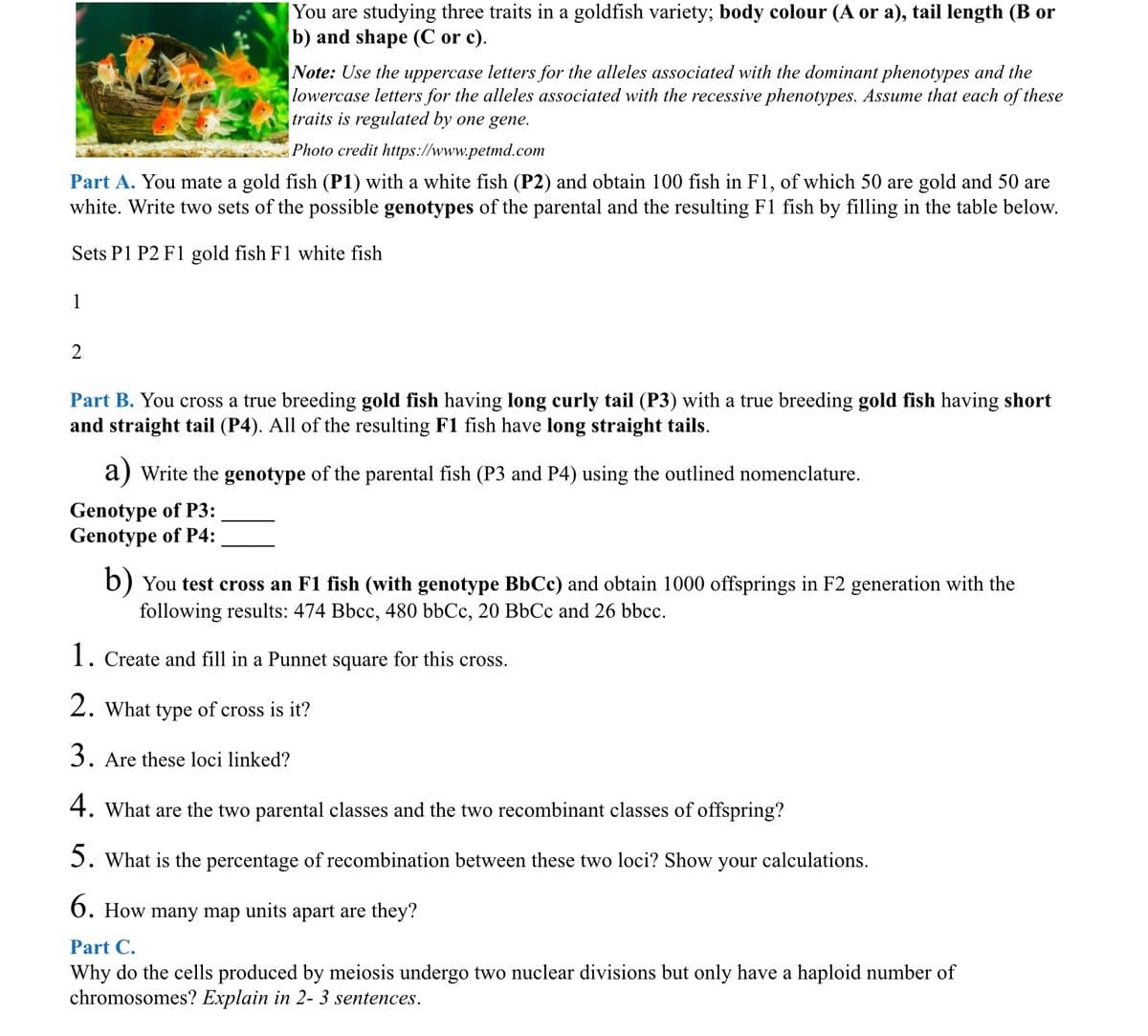|You are studying three traits in a goldfish variety; body colour (A or a), tail length (B or b) and shape (C or c). Note: Use the uppercase letters for the alleles associated with the dominant phenotypes and the lowercase letters for the alleles associated with the recessive phenotypes. Assume that each of these traits is regulated by one gene. Photo credit https://www.petmd.com Part A. You mate a gold fish (P1) with a white fish (P2) and obtain 100 fish in F1, of which 50 are gold and 50 are white. Write two sets of the possible genotypes of the parental and the resulting F1 fish by filling in the table below. Sets P1 P2 F1 gold fish F1 white fish 1 2 Part B. You cross a true breeding gold fish having long curly tail (P3) with a true breeding gold fish having short and straight tail (P4). All of the resulting F1 fish have long straight tails. a) Write the genotype of the parental fish (P3 and P4) using the outlined nomenclature. Genotype of P3: Genotype of P4: b) You test cross an F1 fish (with genotype BbCe) and obtain 1000 offsprings in F2 generation with the following results: 474 Bbcc, 480 bbCc, 20 BbCc and 26 bbcc. 1. Create and fill in a Punnet square for this cross. 2. What type of cross is it? 3. Are these loci linked? 4. What are the two parental classes and the two recombinant classes of offspring? 5. What is the percentage of recombination between these two loci? Show your calculations. 6. How many map units apart are they?
Genetic Recombination
Recombination is crucial to this process because it allows genes to be reassorted into diverse combinations. Genetic recombination is the process of combining genetic components from two different origins into a single unit. In prokaryotes, genetic recombination takes place by the unilateral transfer of deoxyribonucleic acid. It includes transduction, transformation, and conjugation. The genetic exchange occurring between homologous deoxyribonucleic acid sequences (DNA) from two different sources is termed general recombination. For this to happen, an identical sequence of the two recombining molecules is required. The process of genetic exchange which occurs in eukaryotes during sexual reproduction such as meiosis is an example of this type of genetic recombination.
Microbial Genetics
Genes are the functional units of heredity. They transfer characteristic information from parents to the offspring.
As per our guidelines, we are able to only answer three subparts in a question that is posted. Please post the remaining subparts from Part B as separate questions.
this is the remaining questions
4. What are the two parental classes and the two recombinant classes of offspring?
5. What is the percentage of recombination between these two loci? Show your calculations.
6. How many map units apart are they?

Part B.
A true breeding gold fish with long curly tail is crossed with a true breeding gold fish with short and straight tail. The F1 offspring have long straight tails. Now a F1 is test crossed and 1000 offspring obtained in F2 with the following genotypes:
Bbcc-474
bbCc-480
BbCc-20
bbcc-26
Step by step
Solved in 2 steps


